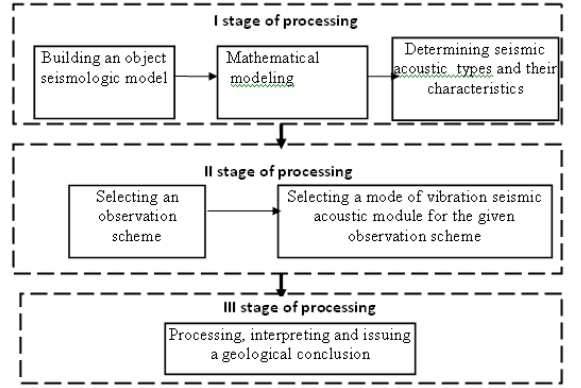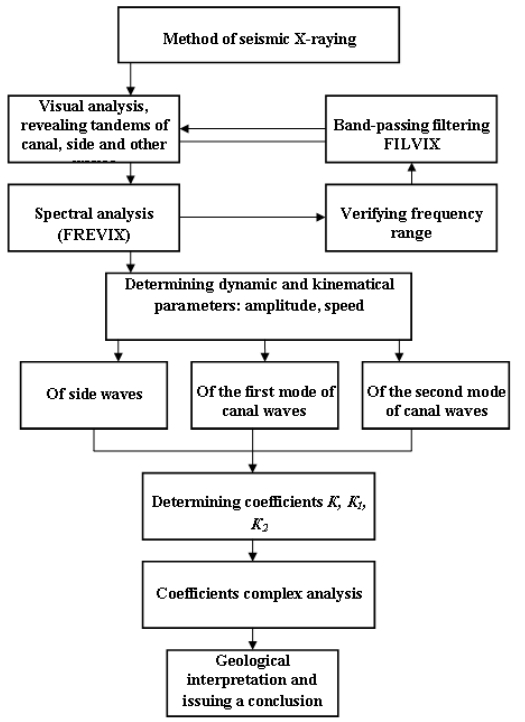SPECIAL FEATURES OF PROCESSING AND INTERPRETING MINING SEISMIC ACOUSTIC INFORMATION
SPECIAL FEATURES OF PROCESSING AND INTERPRETING MINING SEISMIC ACOUSTIC INFORMATION
Research article
Кеnzhin B.М.¹, Smirnov Yu.M.²
1, 2 Каraganda State Technical University, Karaganda, Kazakhstan
Abstract
There has been carried out the analysis of methods obtaining seismic acoustic information obtained from mining geodesic studies. There has been established that the most efficient method is vibration seismic affect on coal-and-rock mass. There have been analyzed special features of such an affect and the requirements imposed to seismic acoustic information. There have been suggested schemes of carrying out mining seismic acoustic operations, the graph of the data processing and interpreting, developed methodologies and methods of carrying out mining seismic studies of coal-and-rock mass.
Key words: coal-and-rock mass, seismic acoustic operations, interpretation, canal wave.
For accident-free operation of highly productive mining equipment (mechanisms, complexes) and provision of maximal safety of miners’ labor there is necessary a reliable forecast of mining-and-geological conditions of coal seams bedding and, first of all, their tectonic breaking.
Timely forecast of geological breaking permits to solve a number of important problems:
– to control mining operations when developing the mining field with established tectonic breakings;
– to increase labor productivity by means of decreasing working tome losses and equipment standing idle (forming operative reserves of power);
– to improve the quality of the coal mined;
– to decrease unproductive expenses connected with sinking worthless mining workings;
– to increase safety methods by means of detecting tectonic breakings, potentially dangerous for sudden outburst of gas, dust and coal.
To increase the level of mining geophysical studies effectiveness it’s necessary to establish methodological regulations of information obtaining. Mining seismic acoustic information processing is carried out on the base of SCS-2 system and consists of several stages. Each stage, in turn, consists of separate substages.
The preliminary stage of processing consists of the following procedures: demultiplexing (ДЕМUХ) and editing mining seismic records, making up a passport (РАS, PASFRM) and forming (COMPROF) an observation profile of MRW CDP (or a fiction observation profile for MSX). These procedures of processing are standard in SCS-3 system and are considered in details in [1].
At the first stage based on the analysis of mining geological information there is built a seismologic model of the coal-and-rock mass characteristic of this seam section and carried out the calculation of theoretical disperse curves of the first and second models group speed. The calculations were carried out by the programs developed in PNIUI. Based on the dispersion curves obtained there is valuated a possible range of changing parameters of Airy phase for the first and second models of the canal wave for the given seam section.
At the second stage there is carried out a spectral analysis of seismic tracks (FREVIX). Based on the joint analysis of theoretical disperse curves and spectra there are determined the filtration ranges for separating the first and the second waves. The seismic records filtered are determined by the initial data for the following processing stages.
When using a pulse source of excitation elastic vibrations the main task was in revealing and detecting the “useful” waves carrying informative parameters of the object studied. This was achieved by using special methods in mining operations (signal accumulating), as well as at the stage of processing by filtration and other special programs.
Using a vibration seismic module permits to increase significantly the effectiveness of seismic acoustic studies due to selecting determinate parameters of the source, as well as increasing parameters of the “useful” signals, which will permit to simplify a standard graph of processing due to decreasing special programs. In Figure 1 there is shown a scheme of mining seismic acoustic operations consisting of three stages.

Figure 1 – Scheme of mining seismic acoustic operations
The following processing of seismic acoustic data depending on the seismic method is carried out by two variants. Each of these methods has its own methodology, processing graph and interpreting seismic acoustic data which are considered separately.
When studying a seam section with the help of two methods of reflected waves and X-raying, the processing of seismic acoustic information begins with the method of X-raying, which permits to determine the first and second canal waves parameters and to use them in processing and interpreting the waves reflected by this method. The last stage of processing in this case is a complex analysis and interpretation of the processing results which permits to increase the information capacity and credibility of seismic acoustic forecast of coal seams breaking [2].
The processing the reflected waves method consists of the following stages (Figure 2):

Figure 2 – Processing and interpreting graph of reflected waves method data
– Hilbet-transforms (HILB) of filtered seismic tracks with the aim to decrease the effect of dispersion properties of the canal waves on the results of summing by the standard algorithm of the common depth point (CDP) by means of obtaining rounding seismic tracks;
– seismic tracks summing by the CDP algorithm with entering kinematical corrections (SUMI + KINVC). Kinematical corrections are calculated based on comparing theoretical dispersion curves of the group speed and the speed of a straight canal wave propagation along the mining working obtained by seismic records;
– analyzing real-time sections, separating synchronism axes on them which correspond to the waves reflected;
– building a depth section by the method of marking method.
The abovementioned stages of processing differ from the standard graph by that they are built parallel for the first and the second modes of canal waves.
One of the last stages of processing of CDP method of reflected waves is the joint analysis of real-time and depth sections for the first and second modes of canal waves which permits to reveal tectonic breakings by the amplitude up to half of the seam thickness. Reflecting segments separated simultaneously in the depth sections of the first and second modes correspond to the breaking zones with the amplitude that is over half the seam thickness. Reflecting segments obtained in depth segments only for the second mode cam be considered as breaking zones with the amplitude 8u up to half the seam thickness.
At the last stage based on the results of the joint analyzing of real-time and depth sections and existing mining geological information there is carried out geological interpretation of the reflecting segments obtained and is issued a seismic forecast of breaking as a conclusion.
The scheme of processing and interpreting the data of seismic X-raying method is shown in Figure 3. Visual analysis of the filtered seismic records is performed with the aim to reveal on seismograms tandems (time windows) of the side, canal (first and second modes) and other types of waves registered in the seam.

Figure 3 – Graph of processing and interpreting the data of seismic acoustic X-raying method
After this there is carried out calculating spectra amplitudes separated on the seismic tracks of the side and canal (first and second modes) waves. Spectra calculation is carried out by FREVIX program of SCS-3 system by means of presetting corresponding time windows. Based on the results of visual analysis and amplitude spectra there is verified the frequency range of the first and second modes of canal waves. If necessary, there is carried out a repeat band-pass filtering of initial seismic records in the verified range and the procedures are repeated.
One of the important stages of the data processing in the method of seismic acoustic X-raying is determining dynamic and kinematical parameters of the side waves of the canal wave first and second modes, as well as calculating coefficients characterizing the ratio of the side, first and second, canal waves parameters mto each other.
The main stage of processing in this method is a complex analysis of the coefficients obtained, dynamic and kinematical parameters of each seismic track (seismic ray) and separating abnormal zones based on the criteria developed. For this stage there is needed a highly qualified experienced engineering-interpreter.
At the last stage there is carried out geological interpreting the abnormal zones separated. Here there is used the whole scope of the existing (a priori) mining geological information.
Thus, from the abovementioned it’s clear that the second mode of the canal wave passes “worse” through the breakings with the amplitude up to half the seam thickness in seismic acoustic X-raying. Consequently, the second mode is “better” reflected from such breakings than the first mode. That’s why in the method of reflected waves as criteria of small-amplitude breakings there are used criteria based on comparing the reflecting segments obtained for the first and second modes. The reflecting segments obtained in the depth sections only for the second mode refer to the zones of the amplitude shearing up to half the seam thickness.
Based on the abovementioned, there is developed a methodology and technology of mining seismic acoustic studies of the coal-and-rock mass.
References
1. Methodological recommendations for studying seismic waves polarization in coal seams. –Donetsk, 1981. –10 p.
2. Pusyzyov N.N. Interpreting the data of seismic exploring by the method of reflected waves. – М., 1959. – P. 452.
